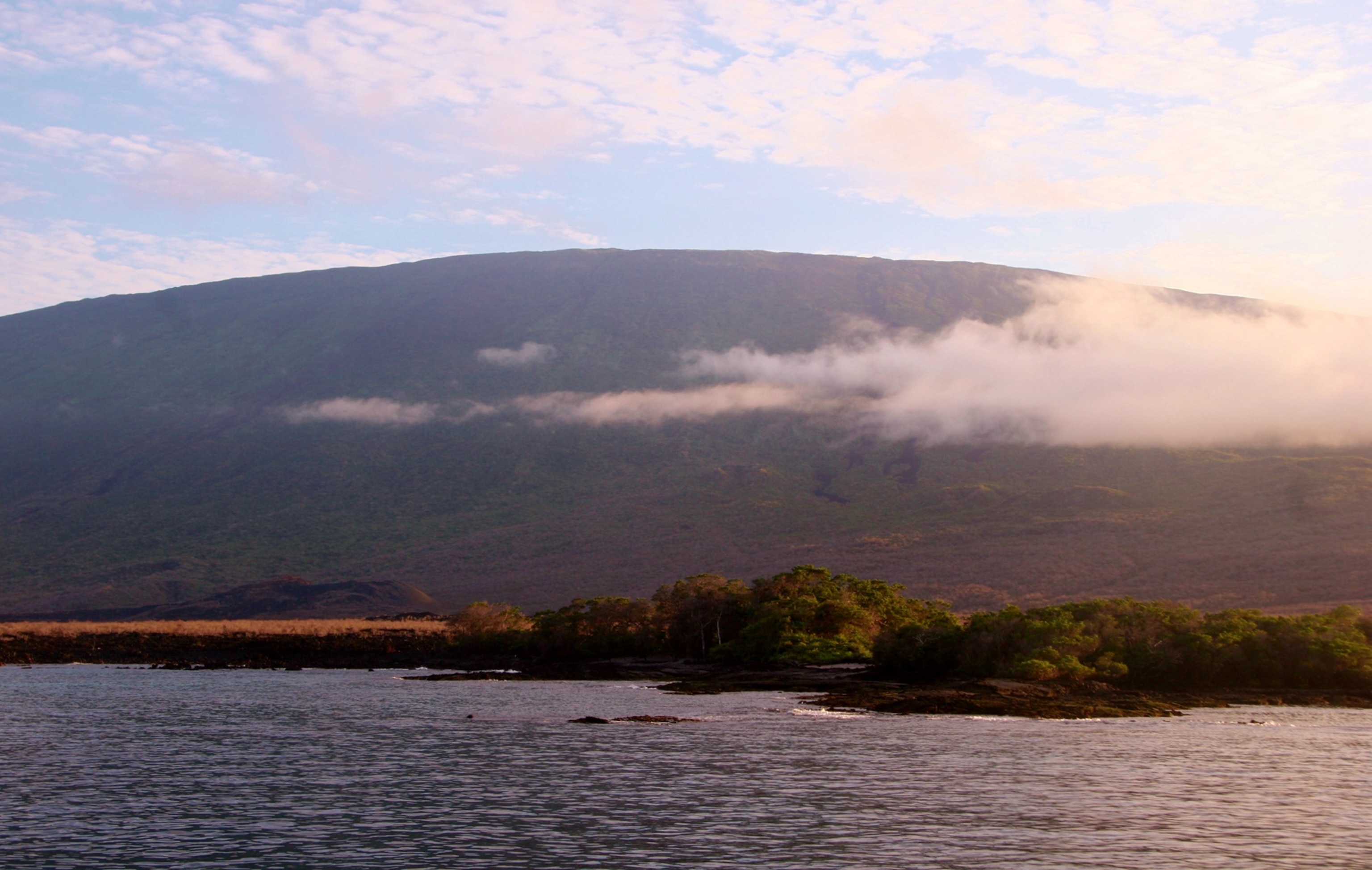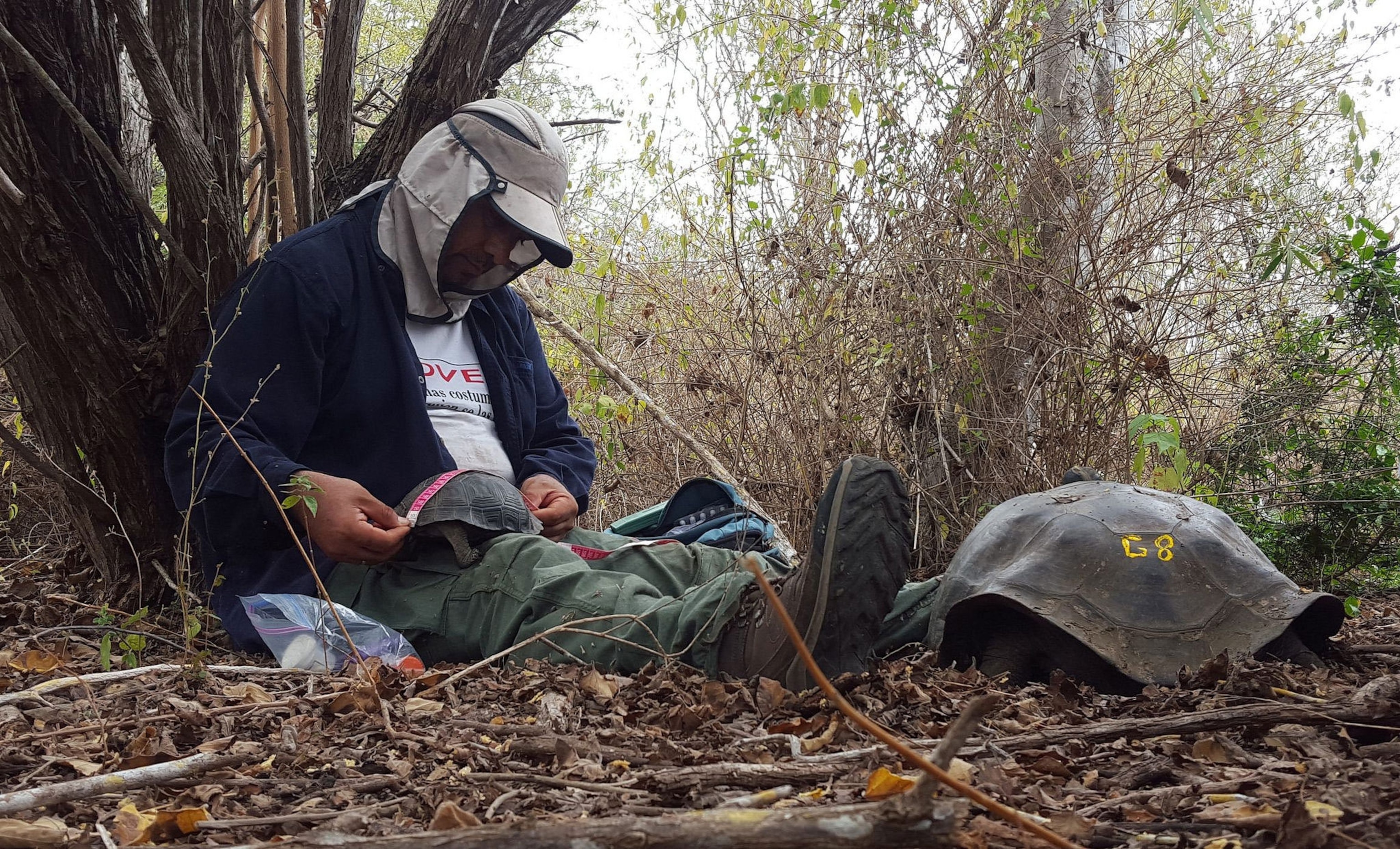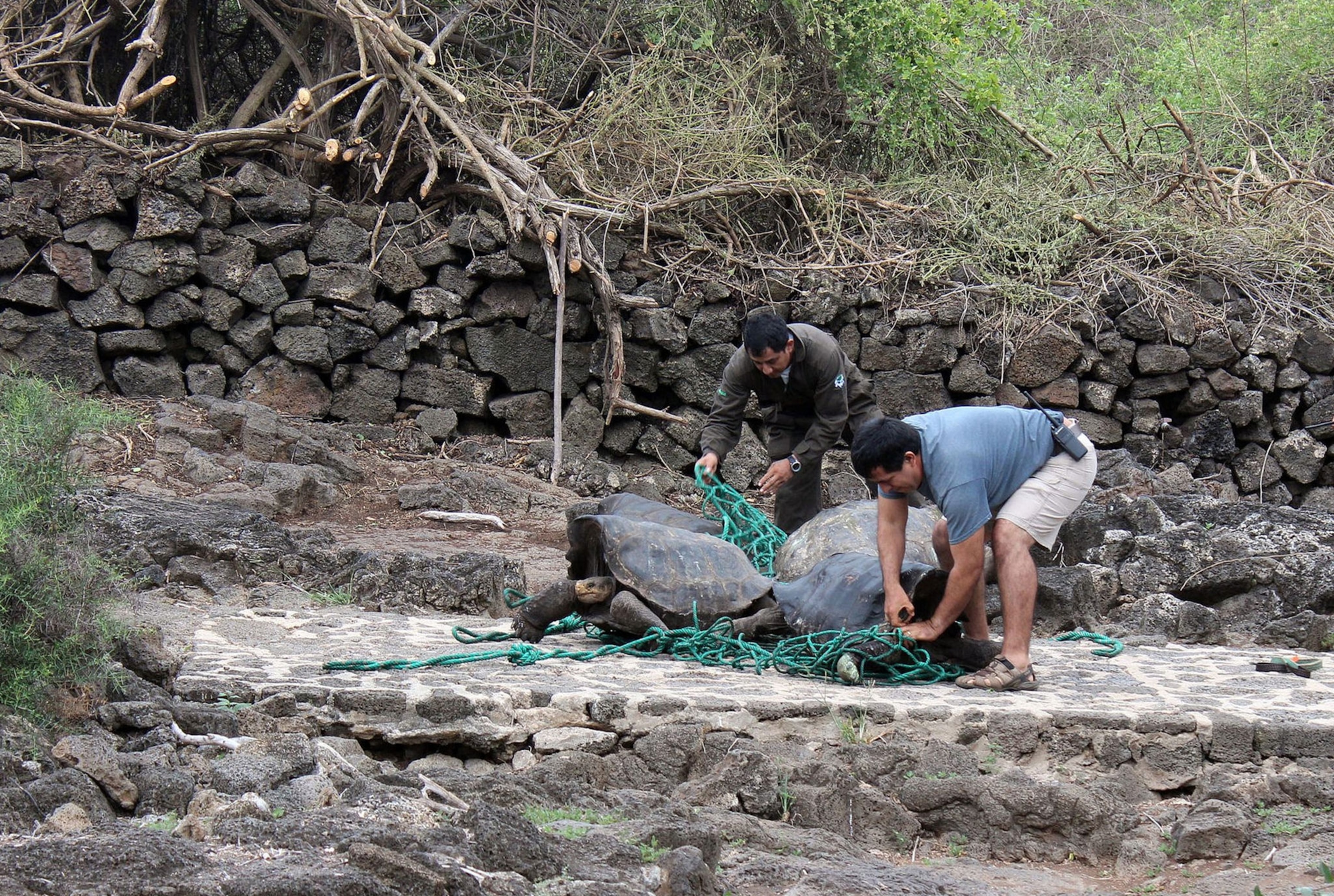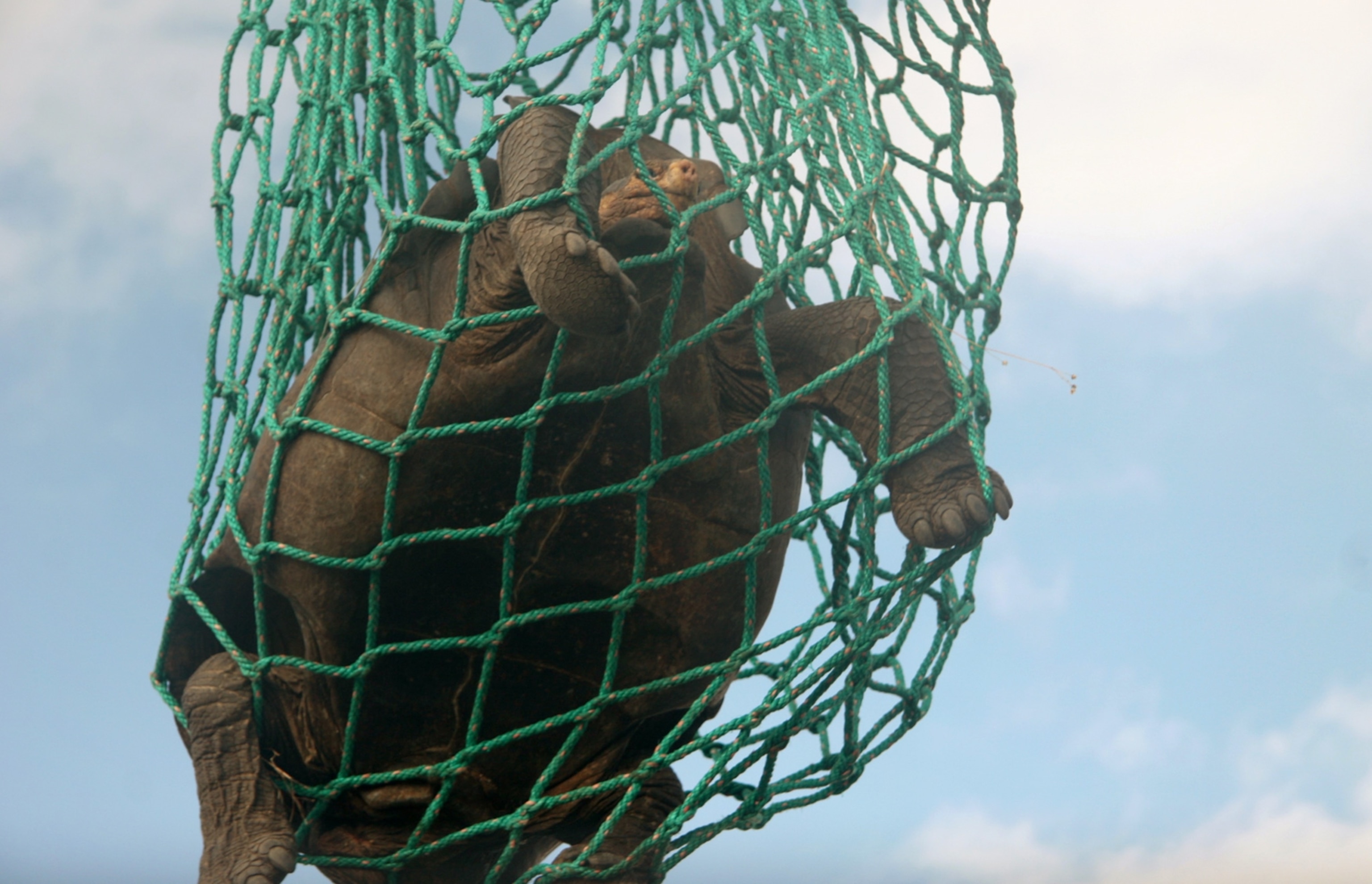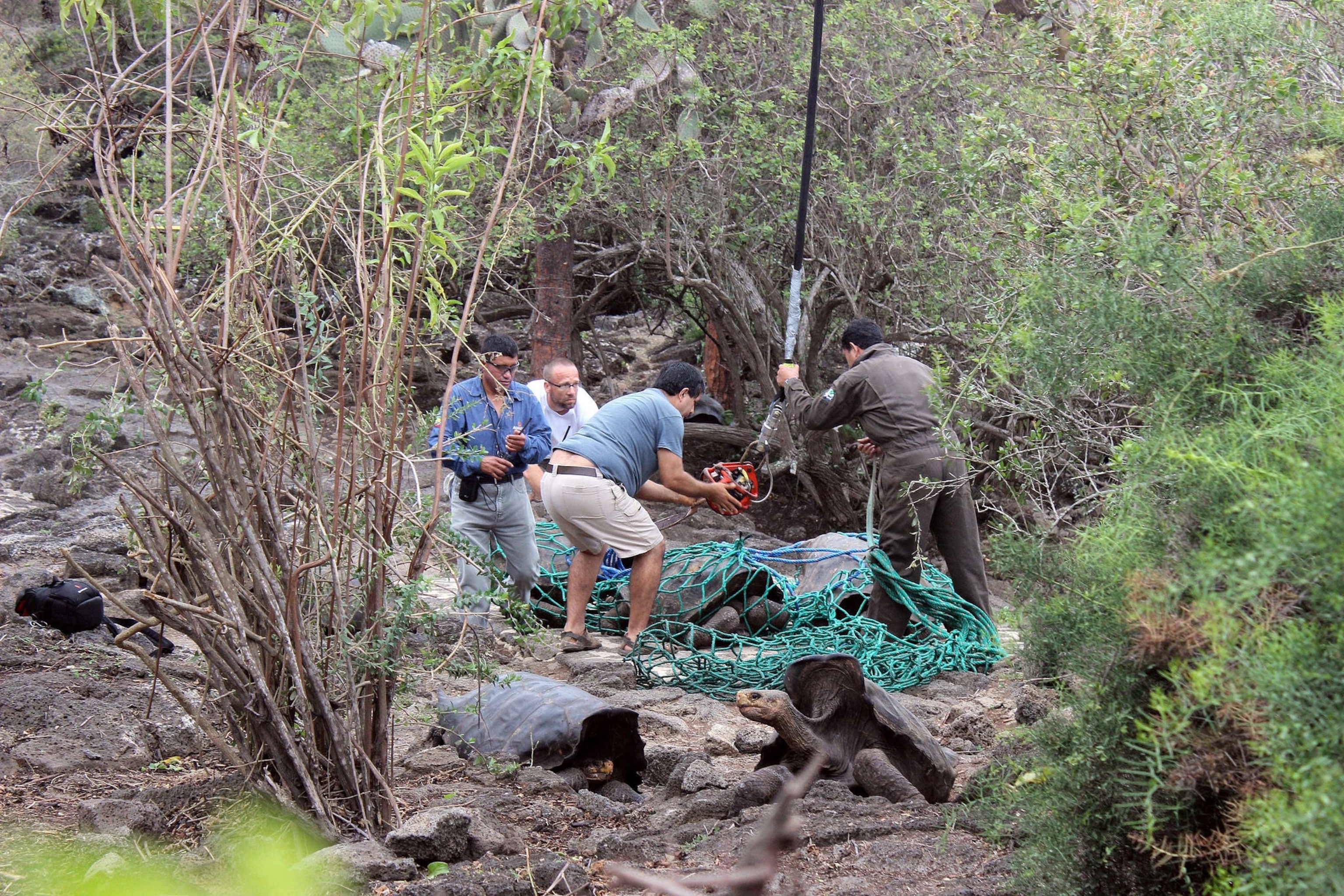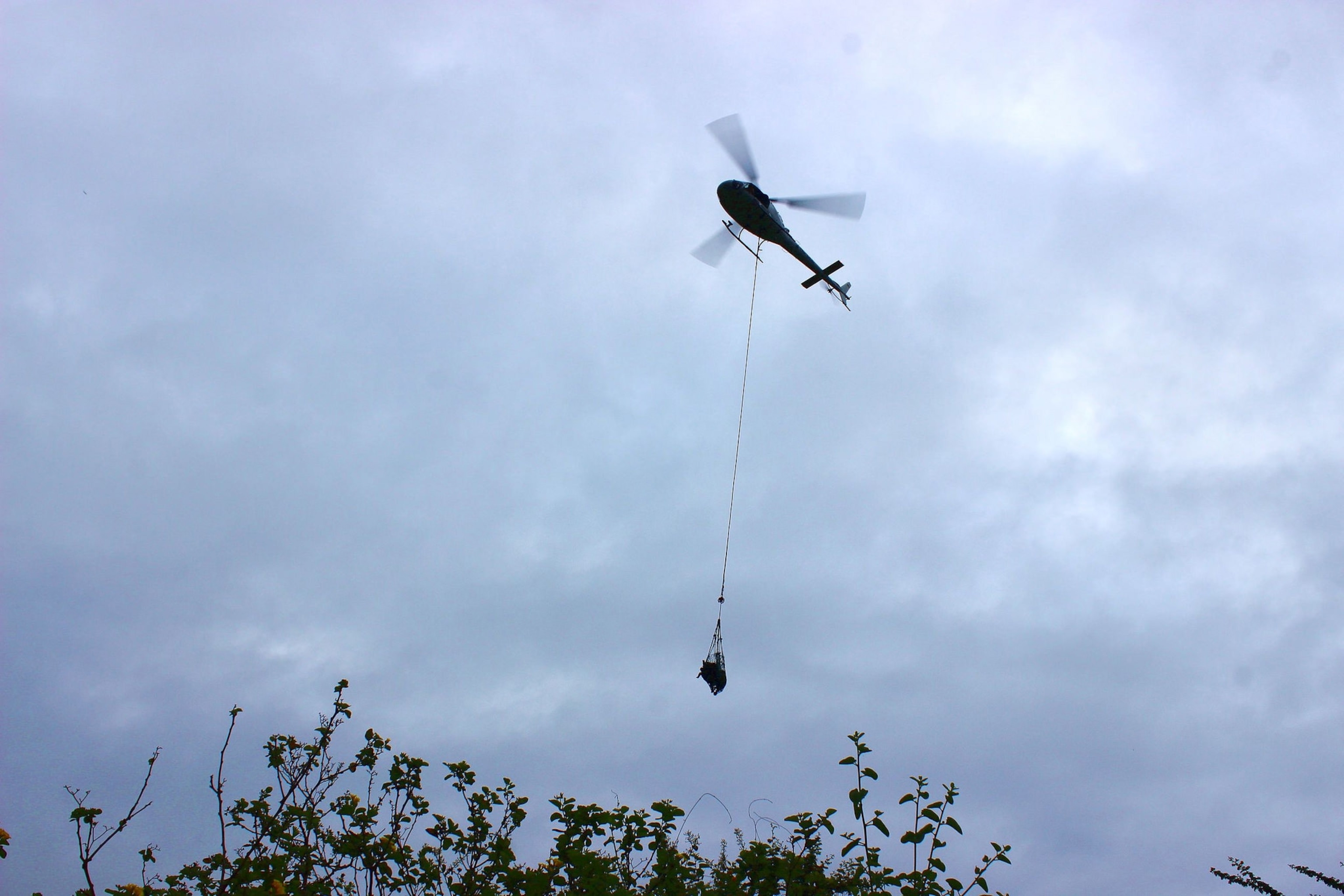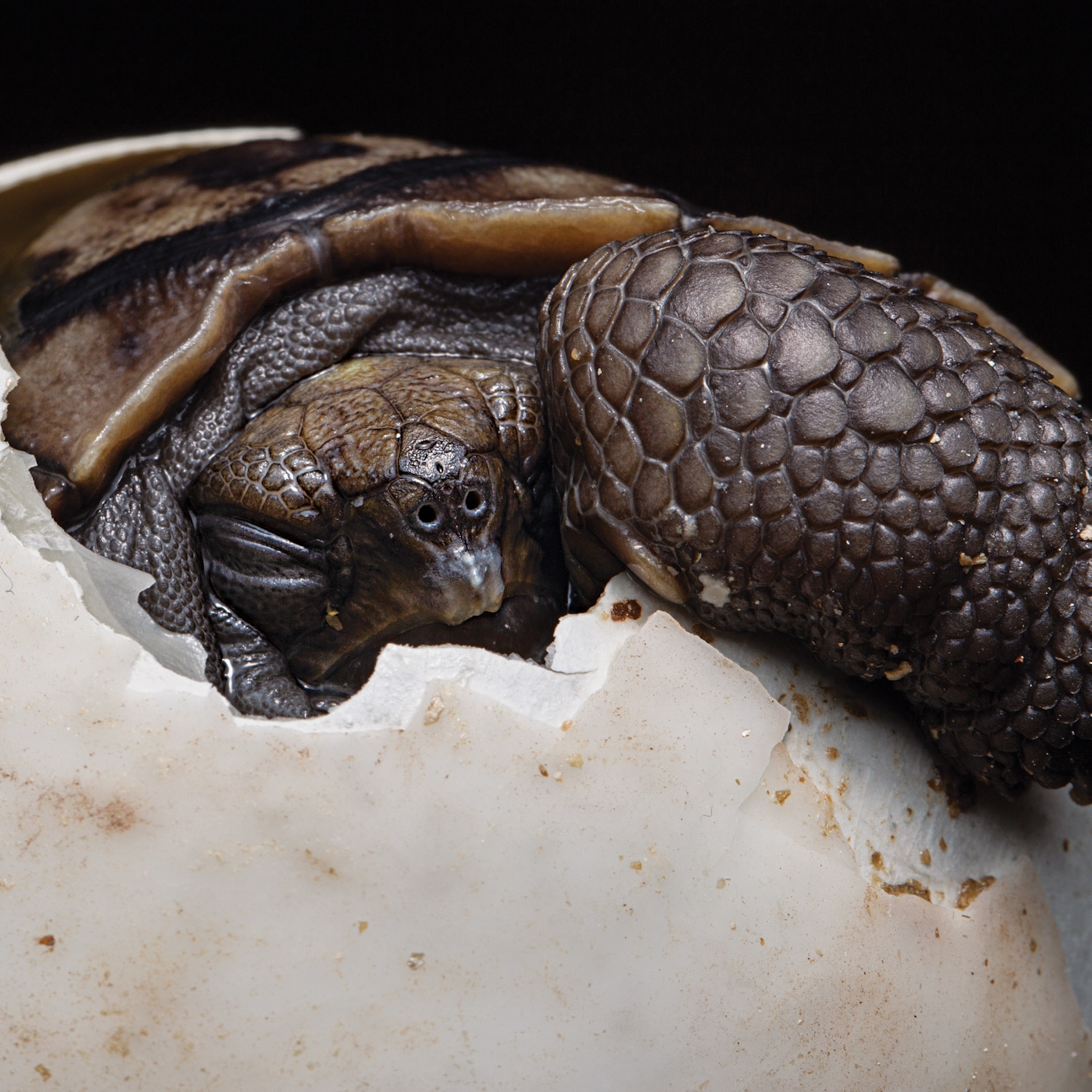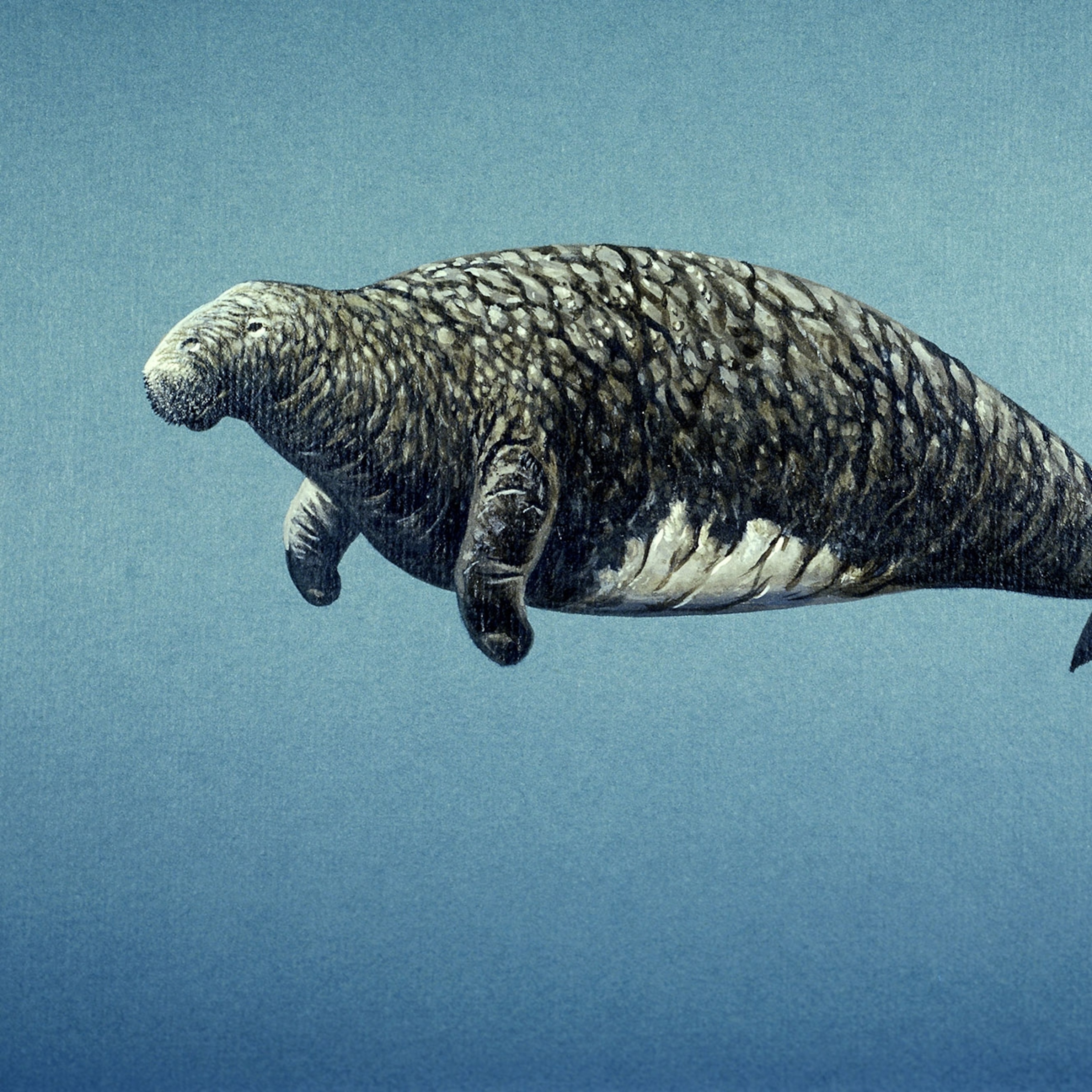
Can Extinct Giant Tortoises Be Brought Back to Life?
Scientists scrambled across lava-covered slopes on the Galápagos Islands to try to resurrect Lonesome George and another extinct species. Here's how they're planning to bring the giant tortoises back.
WOLF VOLCANO, Galápagos — An 80-foot cable dangled beneath a helicopter as it emerged from the mists and flew to an anchored ship, where it gently deposited its living cargo. A century-old giant tortoise lumbered out of a tangle of green netting and stretched its mustard-yellow neck from its shell.
Plucked from lava-strewn slopes, this male tortoise holds the hope for reviving a species that’s been extinct since the 1850s. Known as H-2, he’s a hybrid bearing the strong genetic stamp of tortoises once native to the Galápagos’ Floreana Island.
(Watch a Tortoise Rescue Another in Distress—Was It Trying to Help?)
Weighing in at 380 pounds, H-2 is one of 32 giant tortoises retrieved last month during a $500,000 expedition that could be key to resurrecting two extinct species, the Floreana and the Pinta. The last known Pinta, a hundred-year-old, beloved tortoise dubbed Lonesome George, died in 2012 and was mourned around the world as symbol of global extinctions.

Over ten days in late November, scientists and rangers from Galápagos National Park combed the rugged slopes of Wolf Volcano, collecting at least two animals whose ancestors had been Pinta tortoises like Lonesome George. The hope is that these tortoises, now housed at the national park's headquarters, can be bred to produce hybrid tortoises that are close genetic matches of the ones that once roamed Pinta Island.
Scientists are ebullient about the future of the archipelago's giant tortoises. As the flagship species on most of the major islands, these reptiles have shaped the Galápagos' biological landscape to benefit extraordinary animals and plants found nowhere else. Local legend gives tortoises credit for the islands' name: galápago, an old Spanish word meaning "saddle," which described the shape of their shells.
[The expedition is] one of the most ambitious species recovery efforts ever undertaken in the world.Washington "Wacho" Tapia, Galápagos Conservancy
The expedition—"one of the most ambitious species recovery efforts ever undertaken in the world"—has heightened the possibility of recovering the genetic legacies of the two extinct tortoises, says Washington "Wacho" Tapia, a Galápagos native and director of the giant tortoise restoration initiative at the nonprofit Galápagos Conservancy.
"It will take time to restore Floreana and Pinta tortoises—maybe 200 to 300 years," he says. "But I am absolutely convinced that there are enough tortoises in captivity and in the wild to do this."
Castaway Creatures
Thrust up from a geological hot spot in the Pacific Ocean some five million years ago, the Galápagos remain raw and inhospitable to all but the castaway creatures that swam, floated, or flew in from somewhere else.
Giant tortoises arrived at least a million years ago, gradually colonizing most of the larger islands and adapting over time to their varied conditions. Some, known as domed tortoises, lived in the moist wooded highlands of the larger islands, grazing on the abundant forbs and grasses. Others, known as saddlebacks, evolved on the lower, arid islands, where they developed a shell raised in front to help them reach pads of prickly pears.
When Charles Darwin visited the Galápagos Islands in 1835, hundreds of thousands of giant tortoises were clambering around the spiny shrubs and cacti amid active volcanoes. Massive numbers had already been wiped out by pirates and 19th-century whalers. Early colonists continued the destruction by importing goats, rats, and other invasive species.
Today less than 10 percent of an estimated 200,000 original tortoises remain. The death of Lonesome George marked the fourth extinction among the 15 distinct species that evolved on the islands.
The death of Lonesome George marked the fourth extinction among the 15 species that evolved on the Galápagos.
The place that inspired Darwin's theory of evolution almost 200 years ago is still attracting scientists studying natural selection and species diversity. Species decline is often incremental and invisible, even when species are well understood. Though giant tortoises are the Galápagos' most iconic species, their numbers continued to drop until the 1960s, when the park and the Charles Darwin Research Station began to focus on restoring the most endangered populations.
Modern molecular genetics had not yet been used in animal studies in the 1990s, when James Gibbs, one of the expedition's organizers,became interested in the tortoises. He'd spent ten years working in Galápagos ecosystems, mostly with birds. The thought of losing more giant tortoises appalled him.
"You can become paralyzed by extinction, or you can get to work," says Gibbs, now a professor of conservation biology at State University of New York in Syracuse and science partner with the Galápagos Conservancy.
An Alien on the Islands
Last month's mission to Wolf Volcano was inspired over a decade ago by a scientific enigma.
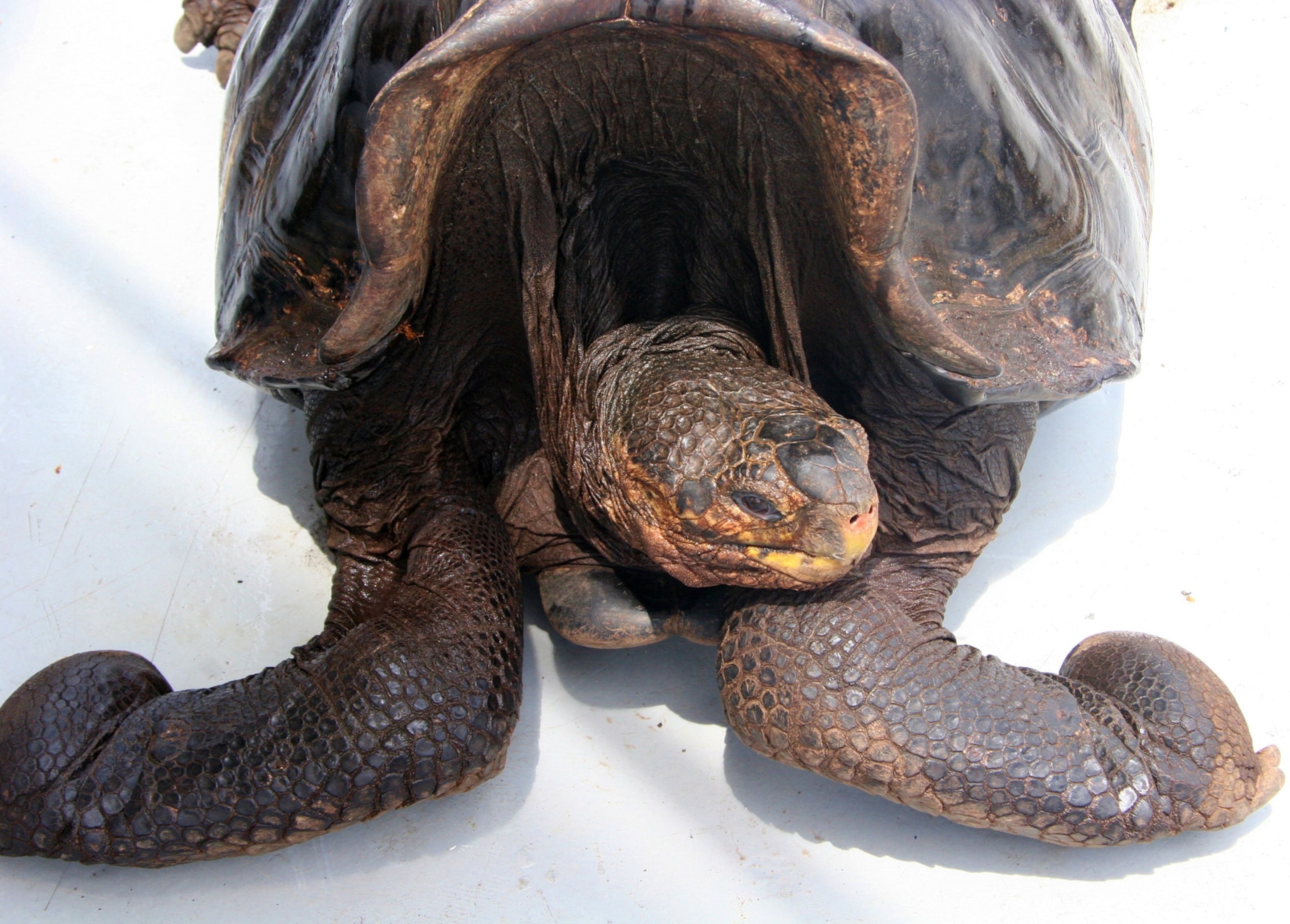
Gibbs had shared his interest in giant tortoises with Adalgisa "Gisella" Caccone, an evolutionary geneticist who directed a conservation genetics lab at Yale University. In 1994 the Yale group joined the park service to launch a systematic survey of Galápagos tortoise genetics.
"As evolutionary biologists we thought it would be interesting to study how a species evolved in the place where Darwin's theory of evolution by natural selection began," says Gibbs. "We didn't realize we were developing a blueprint for restoration."
Park rangers and scientists collected blood samples from giant tortoises, then turned them over to Caccone. When she analyzed the samples from Wolf Volcano, she was puzzled. They contained genetic material that did not match tortoise species living there.
You can become paralyzed by extinction or you can get to work.James Gibbs, State University of New York in Syracuse
"Something odd was here—like something from Mars," says Caccone. Assuming she'd made a mistake, she ran the analyses again. Again she found samples alien to the tortoises native to Wolf Volcano. So she turned to museum specimens and carefully reconstructed the genetic profile of extinct species identified as Floreana and Pinta tortoises. To her surprise, the unidentified tortoise DNA from Wolf Volcano matched.
This anomaly sent the evolutionary biologists to obscure logbooks kept by 19th-century sailors. To survive once they left Galápagos, whalers and admirals alike routinely filled the hulls of their ships with tortoises as food for their years-long journeys. When they entered the open seas near Wolf Volcano, they sometimes had to reduce weight by tossing tortoises overboard. Caccone related one account describing the waters near Wolf as "bubbling with tortoises—hundreds of them."
Those that made it to dry land are the ancestors of the tortoises that so puzzled Caccone.
Here on Wolf Volcano, on this most remote and unexplored sector of the Galápagos, their genetic material has been preserved. It could lead to resurrecting close relatives of the extinct species.
Machete Required
Hunting down tortoises with that genetic potential took searchers from sea level to 3,600 feet across unstable fields of lava that lacerated their boots and sliced the flesh of any body part unfortunate enough to make contact.
Something odd was here—like something from Mars.Adalgisa "Gisella" Caccone, Yale University
Setting out on November 18, the group of 57 people from ten countries fanned out over 20 square miles across the western flanks of Wolf Volcano, which last erupted in May. They thrashed through unforgiving thickets of spiny, prickly plants. At higher elevations they encountered lush ferns and vines all but impenetrable without a machete.
The Galápagos park rangers, scientists, and veterinarians met ticks, wasps, and fire ants. Some crossed the Equator on their daily transects; some climbed up and down 1,500 feet daily. Their goal was finding tortoises with shells that flared at the neck, like those of Floreana and Pinta tortoises.
Gibbs, a lean and lanky man whose stride is the length of a giant tortoise, warned the team about falling into the burrows of land iguanas, which can bury a leg up to the knee. "They spend three months making them," he says.
Tortoises can maneuver over the harsh lava, but they prefer smoother ground. "If you don't like it, they don't like it," says Gibbs, as he led a group exploring the territory near a coastal cove fringed by mangroves. Their hard shells allow the tortoises to crawl deep into thorny thickets, and they navigate loose lava rocks with their elephantine feet.
In eight days of exploring, the searchers encountered more than 1,300 giant tortoises and took blood samples from 100.
What's Next? Hot Babes, Cool Dudes
Genetic testing of these blood samples will help determine how to restore these lineages as close as possible to their original state, Gibbs says. Galápagos National Park officials are awaiting advice from the scientists on launching a breeding program.
Tortoise keepers will manipulate the temperature of tortoise eggs during incubation to produce two females for every male. Cold suppresses the female hormone and heat increases it, a peculiarity herpetologists remember as "hot babes, cool dudes." The aim is to achieve the highest genetic diversity possible in the offspring of both species, says Tapia.
Maybe even a first cousin of Lonesome George is still out there, raising hope for a breeding program.
Pinta and Floreana tortoises also would be returned to the islands of their ancestors. As ecosystem engineers, these animals are essential to reestablishing the prehuman ecosystem; without them, some islands have become severely degraded. Tortoises disperse seeds of cacti and other native plants, and create openings in the dense vegetation for other creatures.
Lonesome George's captive-bred relatives will be returned to Pinta Island, where they've been gone since 1972. The return of tortoises to Floreana Island will mark their return after 150 years.
A Ship Awash in Tortoises
After H-2 landed on the park service ship, giant tortoises were delivered nearly every afternoon—sometimes three females sharing a single cargo net, sometimes a lone male. Often the deck of the Sierra Negra was awash in saddleback tortoises skulking among the lifeboat mounts and cargo tie-downs. The scientists implanted transmitters to identify each animal and treated each for parasites, part of the park's strict quarantine procedures.
Tortoises of the Floreana type proliferated: five that Gibbs called "super valuable" and 15 others with high potential for conserving the species. This bodes well for resurrecting Floreana tortoises, he says.
The future of Lonesome George's species is less certain. The expedition captured one male and one female tortoise with high genetic potential—the Adam and Eve of a breeding program for Pinta tortoises. Others retrieved from Wolf Volcano may prove to have promising levels of genetic material, which would provide a slender basis for a breeding program.
"It's a long shot," says Caccone. "Still…"
From her makeshift lab on the deck of the Sierra Negra, she gazed at the looming hulk of Wolf Volcano, where she estimates at least 8,000 giant tortoises are roaming around the slopes.
"We know they are out there—many, many Pinta hybrids," Caccone says. "Maybe even a first cousin of Lonesome George."
It's worth the time and effort to bring them back, she says, even if it takes another 200 years.


